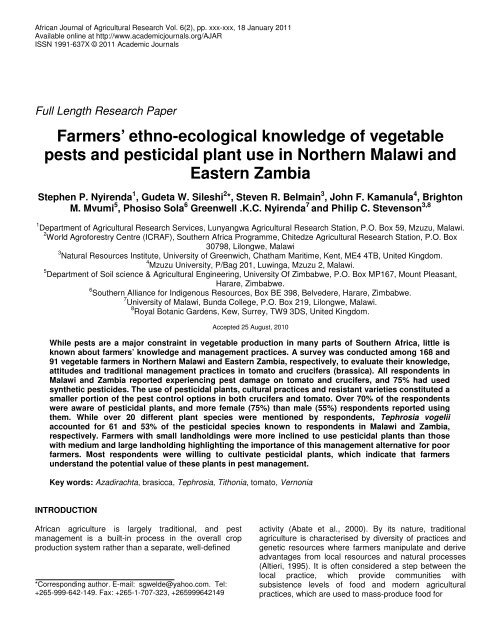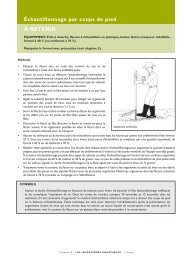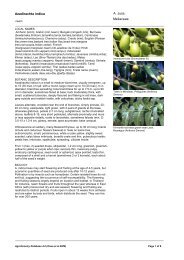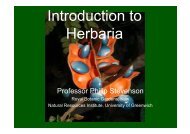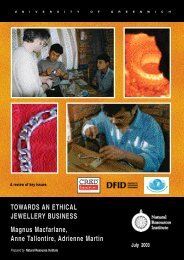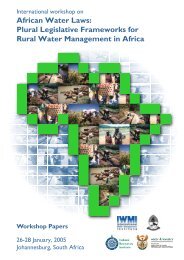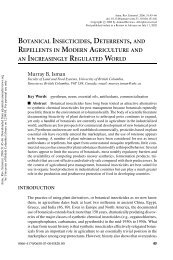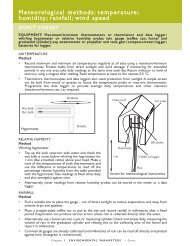Farmers' ethno-ecological knowledge of vegetable pests and ...
Farmers' ethno-ecological knowledge of vegetable pests and ...
Farmers' ethno-ecological knowledge of vegetable pests and ...
Create successful ePaper yourself
Turn your PDF publications into a flip-book with our unique Google optimized e-Paper software.
African Journal <strong>of</strong> Agricultural Research Vol. 6(2), pp. xxx-xxx, 18 January 2011<br />
Available online at http://www.academicjournals.org/AJAR<br />
ISSN 1991-637X © 2011 Academic Journals<br />
Full Length Research Paper<br />
Farmers’ <strong>ethno</strong>-<strong>ecological</strong> <strong>knowledge</strong> <strong>of</strong> <strong>vegetable</strong><br />
<strong>pests</strong> <strong>and</strong> pesticidal plant use in Northern Malawi <strong>and</strong><br />
Eastern Zambia<br />
Stephen P. Nyirenda 1 , Gudeta W. Sileshi 2 *, Steven R. Belmain 3 , John F. Kamanula 4 , Brighton<br />
M. Mvumi 5 , Phosiso Sola 6 Greenwell .K.C. Nyirenda 7 <strong>and</strong> Philip C. Stevenson 3,8<br />
1 Department <strong>of</strong> Agricultural Research Services, Lunyangwa Agricultural Research Station, P.O. Box 59, Mzuzu, Malawi.<br />
2 World Agr<strong>of</strong>orestry Centre (ICRAF), Southern Africa Programme, Chitedze Agricultural Research Station, P.O. Box<br />
30798, Lilongwe, Malawi<br />
3 Natural Resources Institute, University <strong>of</strong> Greenwich, Chatham Maritime, Kent, ME4 4TB, United Kingdom.<br />
4 Mzuzu University, P/Bag 201, Luwinga, Mzuzu 2, Malawi.<br />
5 Department <strong>of</strong> Soil science & Agricultural Engineering, University Of Zimbabwe, P.O. Box MP167, Mount Pleasant,<br />
Harare, Zimbabwe.<br />
6 Southern Alliance for Indigenous Resources, Box BE 398, Belvedere, Harare, Zimbabwe.<br />
7 University <strong>of</strong> Malawi, Bunda College, P.O. Box 219, Lilongwe, Malawi.<br />
8 Royal Botanic Gardens, Kew, Surrey, TW9 3DS, United Kingdom.<br />
Accepted 25 August, 2010<br />
While <strong>pests</strong> are a major constraint in <strong>vegetable</strong> production in many parts <strong>of</strong> Southern Africa, little is<br />
known about farmers’ <strong>knowledge</strong> <strong>and</strong> management practices. A survey was conducted among 168 <strong>and</strong><br />
91 <strong>vegetable</strong> farmers in Northern Malawi <strong>and</strong> Eastern Zambia, respectively, to evaluate their <strong>knowledge</strong>,<br />
attitudes <strong>and</strong> traditional management practices in tomato <strong>and</strong> crucifers (brassica). All respondents in<br />
Malawi <strong>and</strong> Zambia reported experiencing pest damage on tomato <strong>and</strong> crucifers, <strong>and</strong> 75% had used<br />
synthetic pesticides. The use <strong>of</strong> pesticidal plants, cultural practices <strong>and</strong> resistant varieties constituted a<br />
smaller portion <strong>of</strong> the pest control options in both crucifers <strong>and</strong> tomato. Over 70% <strong>of</strong> the respondents<br />
were aware <strong>of</strong> pesticidal plants, <strong>and</strong> more female (75%) than male (55%) respondents reported using<br />
them. While over 20 different plant species were mentioned by respondents, Tephrosia vogelii<br />
accounted for 61 <strong>and</strong> 53% <strong>of</strong> the pesticidal species known to respondents in Malawi <strong>and</strong> Zambia,<br />
respectively. Farmers with small l<strong>and</strong>holdings were more inclined to use pesticidal plants than those<br />
with medium <strong>and</strong> large l<strong>and</strong>holding highlighting the importance <strong>of</strong> this management alternative for poor<br />
farmers. Most respondents were willing to cultivate pesticidal plants, which indicate that farmers<br />
underst<strong>and</strong> the potential value <strong>of</strong> these plants in pest management.<br />
Key words: Azadirachta, brasicca, Tephrosia, Tithonia, tomato, Vernonia<br />
INTRODUCTION<br />
African agriculture is largely traditional, <strong>and</strong> pest<br />
management is a built-in process in the overall crop<br />
production system rather than a separate, well-defined<br />
*Corresponding author. E-mail: sgwelde@yahoo.com. Tel:<br />
+265-999-642-149. Fax: +265-1-707-323, +265999642149<br />
activity (Abate et al., 2000). By its nature, traditional<br />
agriculture is characterised by diversity <strong>of</strong> practices <strong>and</strong><br />
genetic resources where farmers manipulate <strong>and</strong> derive<br />
advantages from local resources <strong>and</strong> natural processes<br />
(Altieri, 1995). It is <strong>of</strong>ten considered a step between the<br />
local practice, which provide communities with<br />
subsistence levels <strong>of</strong> food <strong>and</strong> modern agricultural<br />
practices, which are used to mass-produce food for
global distribution (Chhetry <strong>and</strong> Belbahri, 2009; Jeeva,<br />
2006). In Southern Africa, <strong>vegetable</strong> production is fast<br />
transforming from the traditional backyard garden<br />
production to a more intensive systems especially in<br />
areas with supplementary irrigation (Kuntashula et al.,<br />
2006). Nevertheless, it is still dominated by cultivation <strong>of</strong><br />
the same field year after year, <strong>and</strong> heavy dependence on<br />
family labor <strong>and</strong> locally available inputs for soil nutrient<br />
replenishment <strong>and</strong> control <strong>of</strong> weeds, <strong>pests</strong> <strong>and</strong> diseases.<br />
In Malawi <strong>and</strong> Zambia, <strong>vegetable</strong>s are valuable as a<br />
relish, providing dietary vitamins <strong>and</strong> minerals in the<br />
largely maize-based diet <strong>of</strong> rural households. Vegetables<br />
also have high market value <strong>and</strong> generate income<br />
throughout the year (Kuntashula et al., 2006; Tschirley et<br />
al., 2009). According to a survey <strong>of</strong> consumption <strong>and</strong><br />
purchasing habits <strong>of</strong> urban Malawians (Mw<strong>and</strong>ira, 2003),<br />
the most commonly bought <strong>vegetable</strong>s were mustard<br />
(35%), rape (31%), tomato (13%), Chinese cabbage (8%)<br />
<strong>and</strong> cabbage (6%). In a survey conducted in Zambia<br />
(Kabaghe et al., 2009), in 2004, the most valuable<br />
<strong>vegetable</strong>s were tomato, rape <strong>and</strong> cabbage, with about<br />
38, 23 <strong>and</strong> 12% share <strong>of</strong> the total value <strong>of</strong> sales,<br />
respectively. Similarly, in 2008 about 54, 18 <strong>and</strong> 7%<br />
share <strong>of</strong> the total value <strong>of</strong> <strong>vegetable</strong> sales was taken by<br />
tomato, rape <strong>and</strong> cabbage, respectively (Kabaghe et al.,<br />
2009). Rape is especially important for domestic<br />
consumption, <strong>and</strong> the annual per capita consumption has<br />
been estimated at 15 kg (Nkhungulu <strong>and</strong> Msikita, 1985;<br />
Tschirley et al., 2009) thus ranking first in terms <strong>of</strong> the<br />
percentage share <strong>of</strong> total food expenditure <strong>of</strong> <strong>vegetable</strong>s.<br />
Rape also accounts for 95% share <strong>of</strong> the informal fruit<br />
<strong>and</strong> <strong>vegetable</strong> market in Zambia (Kabaghe et al., 2009).<br />
Pest damage severely constrains <strong>vegetable</strong> production<br />
in many parts <strong>of</strong> Southern Africa (Grzywacz et al., 2010;<br />
Kuntashula et al., 2006; Obopile et al., 2008; Sib<strong>and</strong>a et<br />
al., 2000). The tolerance <strong>of</strong> pest damage on <strong>vegetable</strong>s is<br />
<strong>of</strong>ten very low, <strong>and</strong> farmers have to control <strong>pests</strong> whether<br />
the <strong>vegetable</strong> is grown for home consumption or sale. So<br />
far, farmers’ perception <strong>of</strong> <strong>vegetable</strong> <strong>pests</strong> <strong>and</strong> how they<br />
control <strong>pests</strong> are not yet fully understood in Malawi <strong>and</strong><br />
Zambia. The effectiveness <strong>of</strong> farmers’ control practices<br />
also needs to be evaluated so that suitable <strong>and</strong><br />
affordable strategies can be developed. An<br />
underst<strong>and</strong>ing <strong>of</strong> traditional <strong>knowledge</strong> <strong>and</strong> practices may<br />
give an insight <strong>and</strong> underst<strong>and</strong>ing <strong>of</strong> local resources,<br />
different ways <strong>of</strong> controlling <strong>pests</strong> as well as the<br />
<strong>ecological</strong> <strong>knowledge</strong> <strong>of</strong> local communities.<br />
A growing body <strong>of</strong> literature suggests that many<br />
farming communities possess traditional <strong>knowledge</strong> <strong>of</strong><br />
<strong>pests</strong> that affect their crops <strong>and</strong> alternative approaches to<br />
their control (Altieri, 1993; Chhetry <strong>and</strong> Belbahri, 2009;<br />
Price <strong>and</strong> Björnsen, 2006; Sileshi et al., 2008). Traditional<br />
<strong>ecological</strong> <strong>knowledge</strong> (Berkes et al., 2008) is likely to be<br />
accompanied by an equally informed <strong>knowledge</strong> <strong>of</strong> how<br />
<strong>pests</strong> can be controlled. The strong point <strong>of</strong> farmers’<br />
<strong>knowledge</strong> is that it is the product <strong>of</strong> frequent observation<br />
<strong>of</strong> crops during the whole cropping season, <strong>and</strong> it<br />
comprehends continuities within the diverse l<strong>and</strong>scape.<br />
Documenting <strong>and</strong> validating this <strong>knowledge</strong> is especially<br />
useful to set research agenda, for developing messages<br />
for communication, planning campaign strategies <strong>and</strong><br />
form the basis for constructive collaboration between<br />
researchers <strong>and</strong> farmers (Sileshi et al., 2009; Van Mele<br />
et al., 2001). Therefore, the objectives <strong>of</strong> this study were<br />
to (i) identify priority pest problems in crucifers (brassica)<br />
<strong>and</strong> tomato crops <strong>of</strong> resource-poor farmers in Northern<br />
Malawi <strong>and</strong> Eastern Zambia; <strong>and</strong> (ii) evaluate farmers’<br />
practices in <strong>vegetable</strong> pest management including use <strong>of</strong><br />
pesticidal plants as a platform for the development <strong>of</strong><br />
optimised application.<br />
MATERIALS AND METHODS<br />
The study areas<br />
The study was conducte ricts <strong>of</strong> Eastern Zambia (Figure 1). The<br />
majority <strong>of</strong> the people in the study area in Northern Malawi<br />
belonged to the Tumbuka <strong>and</strong> Ngoni ethnic groups, while those in<br />
Eastern Zambia d in Mzimba <strong>and</strong> Rumphi districts <strong>of</strong> Northern<br />
Malawi <strong>and</strong> Chadiza, Chipata <strong>and</strong> Katete dist belonged to the Ngoni<br />
<strong>and</strong> Chewa (Nyanja linguistic) ethnic groups. Knowledge <strong>of</strong> ethnic<br />
<strong>and</strong> linguistic groups is important because this assists in the<br />
underst<strong>and</strong>ing <strong>of</strong> the way local people view <strong>and</strong> define the specific<br />
issues in their area. Mzimba <strong>and</strong> Rumphi districts are located in the<br />
Northern part <strong>of</strong> Malawi in the Viphya (1300 m) <strong>and</strong> Nyika (1700 m)<br />
highl<strong>and</strong>s. Mzimba district has a population <strong>of</strong> 724,873 mostly <strong>of</strong><br />
Tumbuka <strong>and</strong> Ngoni tribes. Rumphi has a population <strong>of</strong> 169,112<br />
predominantly <strong>of</strong> Tumbuka (NSO, 2008).<br />
Data collection <strong>and</strong> analyses<br />
Data were collected using a household survey conducted between<br />
November <strong>and</strong> December 2007 in Northern Malawi <strong>and</strong> Eastern<br />
Zambia. Semi-structured questionnaires were employed in<br />
interviews <strong>of</strong> r<strong>and</strong>omly selected households. A total <strong>of</strong> 91 <strong>and</strong> 168<br />
farmers were interviewed in Eastern Zambia <strong>and</strong> Northern Malawi,<br />
respectively.<br />
The qualitative <strong>and</strong> quantitative data were summarized <strong>and</strong><br />
contingency tables were drawn. The chi-square statistic was used<br />
to analyze in order to test for associations. A generalized linear<br />
model assuming binomial/multinomial error distribution <strong>of</strong> farmer<br />
responses was used to characterize respondents’ awareness <strong>of</strong><br />
pesticidal plants <strong>and</strong> their use <strong>of</strong> these plants for pest control. It was<br />
hypothesized that farmer’s awareness <strong>and</strong> their use <strong>of</strong> pesticidal<br />
plants is a function <strong>of</strong> farmer-specific explanatory variables such as<br />
age, sex, education level <strong>and</strong> years <strong>of</strong> experience in growing<br />
<strong>vegetable</strong> crops. Parameters <strong>of</strong> the logit-linear model were<br />
estimated using the LOGISTIC procedure <strong>of</strong> SAS (SAS, 2001).<br />
RESULTS<br />
Characteristics <strong>of</strong> respondents<br />
The majority (70%) <strong>of</strong> the respondents in both Northern<br />
Malawi <strong>and</strong> Eastern Zambia were men older than 25<br />
years <strong>of</strong> age, <strong>and</strong> had undergone formal schooling (Table<br />
1). Over 83% <strong>of</strong> the respondents were married in both
Figure 1. Map <strong>of</strong> the study areas in Malawi <strong>and</strong> Zambia. Approximate location <strong>of</strong> the districts is denoted<br />
by green oval mark.<br />
Table 1. Percentage <strong>of</strong> respondents according to sex, age, education <strong>and</strong> household size in Northern Malawi <strong>and</strong><br />
Eastern Zambia.<br />
Variable Category Malawi (n=168) Zambia (n=91)<br />
Gender Female 25.6 16.5<br />
Male 74.4 83.5<br />
Age Young (40 years) 33.9 44.0<br />
Education None 0.1 24.2<br />
Primary (up to Std 8) 64.1 57.1<br />
Secondary (>Std 8) 35.3 18.7<br />
Marital Divorce/Widow 10.1 2.2<br />
Married 83.3 96.7<br />
Single 6.6 1.1<br />
Households Small (6 people) 17.9 52.8<br />
countries. About 60% <strong>of</strong> the households in Malawi were<br />
medium to large (4-6 people per household). On the<br />
other h<strong>and</strong> 83.6% <strong>of</strong> the households in Zambia had 4-6<br />
family members (Table 1). Most <strong>of</strong> the respondents (54%<br />
in Malawi <strong>and</strong> 70% in Zambia) had over 10 year <strong>of</strong><br />
farming experience (Table 2). The majority <strong>of</strong> the
Table 2 Percentage <strong>of</strong> respondents according to their experience in farming, l<strong>and</strong>holding size, l<strong>and</strong> tenure <strong>and</strong><br />
preference for tenure <strong>and</strong> appraisal <strong>of</strong> their l<strong>and</strong> holding size in northern Malawi <strong>and</strong> eastern Zambia.<br />
Variable Category Malawi (n=168) Zambia (n=91)<br />
Farming experience Short ( 10 years) 54.2 70.0<br />
L<strong>and</strong> size Small (1 ha) 5.4 77.8<br />
L<strong>and</strong> ownership Chief 4.9 17.6<br />
Borrow 4.9 0<br />
Inherit 80.8 76.9<br />
Rent 7.9 2.2<br />
Private 0.6 3.3<br />
Preferred tenure Customary l<strong>and</strong>* 85.0 60.4<br />
Private/purchase 11.4 38.5<br />
Rent/lease 3.6 1.1<br />
L<strong>and</strong>holding Very small 20.2 18.7<br />
Small 28.0 31.9<br />
Perfect 51.8 49.4<br />
*Customary l<strong>and</strong> is l<strong>and</strong> inherited from family members or given by the chief.<br />
Figure 2. Vegetable crops mentioned by respondents in northern Malawi (a) <strong>and</strong> eastern Zambia (b).<br />
Percentage values were calculated as the proportion <strong>of</strong> all <strong>vegetable</strong> crop species mentioned by the<br />
respondents<br />
respondents (78%) in Zambia owned more than 1 ha <strong>of</strong><br />
l<strong>and</strong>, whereas, in Malawi, l<strong>and</strong>holding size was relatively<br />
small with over 65% owning less than 0.4 ha. Over 76%<br />
<strong>of</strong> the respondents in both countries had inherited l<strong>and</strong>,<br />
while less than 10% had either purchased or<br />
leased/rented the l<strong>and</strong> (Table 2). About 50% <strong>of</strong> the<br />
respondents reckon their l<strong>and</strong>holding is adequate for<br />
farming (Table 2).<br />
Vegetable production patterns in the study areas<br />
Tomatoes, crucifers, onions, cucurbits <strong>and</strong> potatoes were<br />
the most commonly grown <strong>vegetable</strong>s in both countries<br />
(Figure 2). Tomatoes were grown by 94% <strong>of</strong> the<br />
respondents in Malawi <strong>and</strong> 83% <strong>of</strong> the respondents in<br />
Zambia. The most frequently mentioned tomato varieties<br />
were Rodade <strong>and</strong> Money Maker in both Malawi <strong>and</strong>
Table 3 Percentage <strong>of</strong> respondents growing different Brassica <strong>and</strong> tomato varieties in northern Malawi <strong>and</strong> eastern<br />
Zambia.<br />
Country Crop Variety Respondents (%)<br />
Northern Malawi (n=168) Cabbage Florida 37.5<br />
Maracanta 21.2<br />
Drum head 9.6<br />
Gloria 8.7<br />
Mayford 2.9<br />
Sugar loaf 1.0<br />
Inkuqueen 1.0<br />
Rape Giant Essex 10.6<br />
Mustard Unknown 4.8<br />
Tomato Rodade 74.3<br />
Money maker 25.7<br />
Eastern Zambia (n=91) Rape Giant Essex 62.9<br />
Zambia (Table 3). About 51% <strong>of</strong> the Malawian <strong>and</strong> 40%<br />
<strong>of</strong> the Zambian respondents said that they produce two<br />
crops <strong>of</strong> tomatoes in a year. Cruciferous were grown by<br />
75% <strong>of</strong> the respondents in Malawi <strong>and</strong> 85.7% <strong>of</strong> the<br />
respondents in Zambia. However, when values were<br />
calculated as the percentages <strong>of</strong> all <strong>vegetable</strong> crop<br />
mentioned by the respondents, crucifers accounted for 34<br />
<strong>and</strong> 44% (Figure 2). Among the cruciferous crops,<br />
cabbage (Brassica olerancea var capitata), rape<br />
(Brassica napus), Chinese cabbage (Brassica campestris<br />
var chinensis) <strong>and</strong> mustard (Brassica juncea) were<br />
reportedly grown most frequently. Respondents from<br />
Northern Malawi mentioned seven varieties <strong>of</strong> cabbage,<br />
while those in Eastern Zambia reported three varieties<br />
(Table 3). Giant Essex was the most common variety <strong>of</strong><br />
rape in both Malawi <strong>and</strong> Zambia (Table 3). The majority<br />
<strong>of</strong> Malawian respondents (91%) produced crucifers twice<br />
a year. About 66% <strong>of</strong> the Zambian respondents produced<br />
at least two different species/varieties <strong>of</strong> crucifers two to<br />
three times a year, indicating how important they were to<br />
the farmers surveyed.<br />
Hobson 17.1<br />
Choumolier 2.9<br />
Cabbage Drum head 2.9<br />
Gloria 2.9<br />
White rob 2.9<br />
Tomato Money maker 37.5<br />
Rodade 23.2<br />
Tengelo 17.9<br />
Floridade 7.2<br />
Heinz 3.6<br />
Unknown 3.6<br />
Mkushi 3.6<br />
Monpale 1.8<br />
Farmers <strong>knowledge</strong> <strong>of</strong> <strong>pests</strong> <strong>and</strong> management<br />
practices <strong>of</strong> <strong>vegetable</strong> <strong>pests</strong><br />
All <strong>of</strong> the respondents in Malawi <strong>and</strong> Zambia said they<br />
experienced pest damage on tomato <strong>and</strong> crucifers.<br />
According to respondents in both countries the major<br />
<strong>pests</strong> <strong>of</strong> tomatoes are the red spider mite (Tetranychus<br />
evansi), bollworms (Helicorvepa armigera) <strong>and</strong> aphids<br />
(Figure 3). The other <strong>pests</strong> <strong>of</strong> tomatoes mentioned<br />
included red ants, blister beetles, leaf-miners <strong>and</strong><br />
variegated grasshopper mainly Zonocerus variegatus.<br />
The most important <strong>pests</strong> reported on crucifers were<br />
aphids (Brevicoryne brassicae), diamond back moths<br />
(Plutella xylostella), cutworms (Agrotis spp.), webworms<br />
(Hellula undalis), grasshoppers <strong>and</strong> beetles on crucifers<br />
(Figure 3). Because <strong>of</strong> high disease incidence during the<br />
rainy season, most farmers grow <strong>vegetable</strong> during the dry<br />
season.<br />
Over 75% <strong>of</strong> the respondents in Zambia <strong>and</strong> Malawi<br />
had used pesticides to control insect <strong>pests</strong> on crucifers<br />
<strong>and</strong> tomato crops (Figure 4). Respondents sometimes
Figure 3 Major <strong>pests</strong> <strong>of</strong> Brassica <strong>and</strong> tomato mentioned by respondents in northern Malawi (a & c) <strong>and</strong> eastern Zambia (b<br />
& d). Values were calculated as the percentages <strong>of</strong> all insect pest species mentioned by the respondents<br />
reported using pesticides that are hazardous (class I)<br />
according to the WHO classification as well as products<br />
not recommended for control <strong>of</strong> pest in <strong>vegetable</strong> crops<br />
(Table 4 <strong>and</strong> 5). In some instances, farmers only knew<br />
pesticides by their trade names, which vary widely. This<br />
was frequent in Eastern Zambia where the same product<br />
was known by different names.<br />
The use <strong>of</strong> pesticidal plants, cultural practices <strong>and</strong><br />
resistant varieties constituted a smaller portion <strong>of</strong> the pest<br />
control options in both crucifers <strong>and</strong> tomato. Cultural<br />
practices mainly involved h<strong>and</strong>-picking <strong>and</strong> destroying<br />
visible insects. Respondents reported over 20 different<br />
pesticidal plant species (Table 6). These included<br />
Tephrosia vogelii, neem (Azadirachta indica), Mucuna<br />
pruriens, Bobgunnia (Swartzia) madagascarensis,<br />
Euphorbia tirucali, Vernonia amygdalina, Tithonia<br />
diversifolia, Solanum p<strong>and</strong>uriforme <strong>and</strong> tobacco<br />
(Nicotiana tabacum) (Table 6). Respondents in the study<br />
areas sometimes identified the same species with<br />
different local names. The values presented in Table 6<br />
were calculated as the percentages <strong>of</strong> all species<br />
mentioned by the respondents. This was done to enable<br />
listing <strong>of</strong> priority species for further studies. Accordingly,<br />
T. vogelii accounted for 67% <strong>and</strong> 63% <strong>of</strong> the species<br />
known to the respondents as pesticidal plants in Northern<br />
Malawi <strong>and</strong> Eastern Zambia, respectively (Table 4).<br />
However, only 13.2% <strong>of</strong> the respondents had actually<br />
used T. vogelii for pest control despite most being aware<br />
<strong>of</strong> it. T. diversifolia, V. amygdalina, E. tirucali <strong>and</strong> A.<br />
indica were the other most frequently reported pesticidal<br />
plant species but there may be numerous others yet to be<br />
identified.<br />
Awareness <strong>of</strong> pesticidal plants was associated<br />
significantly only with the educational level <strong>of</strong><br />
respondents. The significant determinants <strong>of</strong> use <strong>of</strong><br />
pesticidal plants were gender (χ 2 = 6.0, P = 0.014),<br />
education (χ 2 = 10.3, P = 0.006) <strong>and</strong> l<strong>and</strong> holding size (χ 2<br />
= 15.9, P = 0.004) (Table 7). More female respondents<br />
(75%) were reported using pesticidal plants than their<br />
male counterparts (55%). The majority <strong>of</strong> respondents<br />
(73%) who attended secondary school had used<br />
pesticidal plants while 93% <strong>of</strong> those who did not go to
Figure 4. Control measures mentioned by respondents in a) northern Malawi <strong>and</strong> b) eastern Zambia. Values were calculated as the<br />
percentages <strong>of</strong> all control measures mentioned by the respondents<br />
Table 4. Percentage respondents using synthetic pesticides for <strong>vegetable</strong> pest control in Northern Malawi<br />
<strong>and</strong> their WHO classification.<br />
Pesticide Respondents (%) WHO class*<br />
Phoskil/Parathion/Protein C 25.2 I<br />
Cypermethrin/Ripcord 22.7 II<br />
Azodrin 13.6 I<br />
Karate/Lambda cyhalothrin/Fenthion 10.9 II<br />
Carbaryl 6.2 II<br />
Dithane 5.6 0<br />
Copper oxychloride 4.4 III<br />
Bravo/Daconil/Chlorothalonil 3.9 U<br />
Dimethoate 2.9 II<br />
Actellic 1.4 I<br />
Dursban/Chlorpyrifos 1.1 II<br />
Funguran/Copper hydroxide 0.7 III<br />
Novachlorvos 0.6 I<br />
Acephate/Orthene 0.6 III<br />
Metaphos/Methamidophos 0.1 I<br />
*WHO classification found at http://www.who.int/ipcs/publications/pesticides_hazard/en/. (I = extremely or highly<br />
hazardous; II = moderately hazardous; III = slightly hazardous; U = unlikely to present acute hazard; 0 =<br />
basic)<br />
school did not use pesticidal plants. Farmers with small<br />
l<strong>and</strong>holdings were more inclined to use pesticidal plants<br />
than those with medium <strong>and</strong> large holdings. Less than<br />
22% <strong>of</strong> respondents with small l<strong>and</strong>holdings had not used<br />
pesticidal plants. On the other h<strong>and</strong>, 70% <strong>of</strong> those with<br />
large l<strong>and</strong>holdings said they have not used them. There<br />
is clearly a strong association between relative wealth<br />
<strong>and</strong> interest in alternatives to synthetic pesticides that<br />
may simply be due to resource endowment <strong>and</strong><br />
corroborates our assumption that they are most relevant
Table 5. Percentage respondents using specific synthetic pesticides in eastern Zambia <strong>and</strong> their WHO<br />
classification.<br />
Name Respondents (%) WHO class*<br />
Phoskil/Monocrotophos 41.4 I<br />
Copper oxychloride 9.1 III<br />
Fenkil 4.5 I<br />
Karate 3.5 II<br />
Kanoma/Canon/Yakanona/Lakanona(Milky) 8.0 -<br />
Cotton pesticides 2.8 -<br />
Diefen/Dithane 4.2 0<br />
Spear 2.1 -<br />
Doom 1.7 -<br />
Malathion/Marazone 2.4 III<br />
Soluba 2.4 II<br />
Decitab 1.4 I<br />
Delta-x 100EC 1.4 II<br />
Fortis k 1.4 -<br />
Sailax 1.4 II<br />
Acetan 1.0 III<br />
Batha 1.0 II<br />
Mathioruz 1.0 III<br />
Surf 1.0 -<br />
Twatonge 1.0 -<br />
Cypermethrin/ Sepermefin/Fastac 2.4 II<br />
Nicotine sulphate 0.7<br />
Red spider killer 0.7 I<br />
Spur acetamirids 0.7<br />
Vagila 0.7 -<br />
Dik<strong>of</strong> 0.3 II<br />
Dursban 0.3 II<br />
Logo/Dimethoate/Rogor 0.3 II<br />
Sylesc 0.3 -<br />
Tetex 0.3 -<br />
*WHO classification found at http://www.who.int/ipcs/publications/pesticides_hazard/en/. (I = extremely or highly<br />
hazardous; II = moderately hazardous; III = slightly hazardous; U = unlikely to present acute hazard; 0 =<br />
basic)<br />
Table 6. Species <strong>of</strong> pesticidal plants known to respondents (in %) in Eastern Zambia <strong>and</strong> Northern Malawi.<br />
Species name Local name (s) Zambia Malawi<br />
Tephrosia vogelii Ububa, Mtetezga, Gulinga, Muthuthu 60.7 53.4<br />
Vernonia amygdalina Soyo, Mluluzga, Futsa NM 10.2<br />
Tithonia diversifolia Belibeli, Heji 3.3 7.1<br />
Euphorbia tirucali Nkadze, Nkhadzi, Mduzi 3.3 6.8<br />
Solanum p<strong>and</strong>uriforme Nthula, Nthuma NM 4.8<br />
Azadirachta indica Neem 5.0 2.7<br />
Bobgunnia madagascarensis Mchelekete, Mulundu, Ndale, Kasokosoko 3.3 2.7<br />
Mucuna pruriens Chitedze 5.0 NM<br />
Sesbania sesban Jerejere 3.3 NM<br />
Euphorbia ingens Mlangale NM 2.0<br />
Terminalia sericea Mjoyi NM 2.0<br />
Dolichos kilim<strong>and</strong>scharicus Dema, Dindya NM 1.7
Table 6. count’d<br />
Nicotiana tabacum Tobacco, Fodya, Hona 1.7 1.7<br />
Toona ciliate Senderera 1.0 1.4<br />
Alium cepa Onion, Anyezi, Hanyezi 1.7 NM<br />
Capcicum spp Pepper, Sabola, Tsobola 1.7 NM<br />
Aloe vera L. Chinthembwe NM 0.3<br />
Cassia abbreviate Mubabani NM 0.3<br />
Cussonia spp Chibwabwa NM 0.3<br />
Alium sativum Garlic, Adyo NM 0.3<br />
Lantana camara L Maluwa NM 0.3<br />
Parinari spp Mwambula, Mbula, Muula NM 0.3<br />
Erythrophleum suaveolens Mwayi, Mwavi NM 0.3<br />
Agave sisaliana Sisal, Kholokoto, Khonje NM 0.3<br />
Tagetes minuta Welensky, Marigold NM 0.3<br />
NM= Not Mentioned<br />
Table 7. Logit-linear model results on determinants <strong>of</strong> farmers’ <strong>knowledge</strong> <strong>and</strong> use <strong>of</strong> pesticidal plants in<br />
northern Malawi <strong>and</strong> eastern Zambia.<br />
Parameter Category Estimate (s.e.) Wald χ 2 Probability<br />
Northern Malawi -1.12 (0.23) 24.82
Figure 5. Perception <strong>of</strong> availability <strong>of</strong> pesticidal plants among Malawian <strong>and</strong> Zambian respondents.<br />
with reports from other parts <strong>of</strong> Zambia (Kuntashula et<br />
al., 2006) <strong>and</strong> Malawi (Mw<strong>and</strong>ira, 2003) showing that<br />
farmers grow <strong>vegetable</strong>s during both the wet season (in<br />
the up-l<strong>and</strong> fields) <strong>and</strong> dry season (in the wetl<strong>and</strong>s). With<br />
the availability <strong>of</strong> heat-tolerant cultivars, crucifers such as<br />
cabbage are now cultivated throughout the year in<br />
southern Africa (Kfir, 2003). This has implications on the<br />
build-up <strong>of</strong> pest populations. The results <strong>of</strong> this study also<br />
support earlier reports that tomatoes <strong>and</strong> crucifers are the<br />
main <strong>vegetable</strong>s grown widely in the two countries<br />
(Nkhungulu <strong>and</strong> Msikita, 1985; Obopile et al., 2008;<br />
Theu, 2008). This indicates how important these<br />
<strong>vegetable</strong>s are to the subsistence farmers in the study<br />
areas.<br />
According to the farmers’ perceptions, red spider mite<br />
<strong>and</strong> bollworms are the major insect <strong>pests</strong> <strong>of</strong> tomato, while<br />
the diamond back moth, webworms <strong>and</strong> aphids are major<br />
<strong>pests</strong> <strong>of</strong> crucifers in Northern Malawi <strong>and</strong> Eastern<br />
Zambia. This is consistent with the literature from other<br />
parts <strong>of</strong> Southern Africa (Grzywacz et al., 2010; Obopile<br />
et al., 2008; Sib<strong>and</strong>a et al., 2000). The red spider mite is<br />
an invasive species in Africa <strong>and</strong> the present findings<br />
highlight its increasing importance in the region. Wide<br />
expansion <strong>of</strong> the mite to new areas in Africa has been<br />
predicted (Migeon et al., 2009), thus new technologies to<br />
manage this pest that are particularly relevant for<br />
resource-poorest farmers need to be identified <strong>and</strong><br />
promoted. The diamond back moth <strong>and</strong> aphids (B.<br />
brassicae, Lipaphis erysimi <strong>and</strong> Myzus persicae) have<br />
been identified as the most damaging <strong>pests</strong> <strong>of</strong> crucifers in<br />
most <strong>of</strong> Eastern <strong>and</strong> Southern Africa (Grzywacz et al.,<br />
2010; Kfir, 2003; Sib<strong>and</strong>a et al., 2000) <strong>and</strong> the present<br />
survey confirms this to be the case for Malawi <strong>and</strong><br />
Zambia too. Other major <strong>pests</strong> <strong>of</strong> crucifers include<br />
caterpillars such as the cabbage webworm that seriously<br />
damage cabbage in Eastern Zambia (Kuntashula et al.,<br />
2006).<br />
Results <strong>of</strong> this study are also in agreement with reports<br />
<strong>of</strong> the growing dependence on synthetic insecticides for<br />
the control <strong>of</strong> <strong>vegetable</strong> crop <strong>pests</strong> (Grzywacz et al.,<br />
2010; Obopile et al., 2008; Orr <strong>and</strong> Ritchie, 2004). For<br />
example, Orr <strong>and</strong> Ritchie (2004) reported up to 19<br />
applications to tomato <strong>and</strong> 14 applications to cabbage<br />
per year in the wetl<strong>and</strong>s <strong>of</strong> Southern Malawi. Most <strong>of</strong> the<br />
pesticides applied are potent toxins <strong>and</strong> their intensive<br />
use poses potential hazards to humans, livestock <strong>and</strong> the<br />
environment (Chambers et al., 2001; Ngowi et al., 2007).<br />
The fact that farmers applied insecticides that were not<br />
recommended for <strong>vegetable</strong> pest control is indicative <strong>of</strong><br />
the poor <strong>knowledge</strong> associated with pesticide use <strong>and</strong><br />
the potential problems this can cause. Incorrect use can<br />
be ineffective <strong>and</strong> even exacerbate the problem by<br />
encouraging the emergence <strong>of</strong> resistant pest populations.<br />
For example, the diamond back moth has developed<br />
resistance to a wide range <strong>of</strong> common insecticides in<br />
Africa <strong>and</strong> Asia (Grzywacz et al., 2010). With the<br />
widespread use <strong>of</strong> insecticides in Southern Africa, local<br />
populations <strong>of</strong> this pest have started developing<br />
resistance to synthetic pyrethroids, organophosphates<br />
<strong>and</strong> carbamates (Kfir, 2003). The indiscriminate use <strong>of</strong><br />
chemical pesticides to achieve higher <strong>vegetable</strong> yields<br />
could lead to disruption <strong>of</strong> natural control systems,<br />
increase the risk <strong>of</strong> contamination <strong>of</strong> the farm<br />
environment, pesticide residues in fresh produce <strong>and</strong>
Percentage <strong>of</strong> cases<br />
60<br />
50<br />
40<br />
30<br />
20<br />
10<br />
0<br />
Traditional healer<br />
Friends & parents<br />
Extension<br />
a)<br />
Researchers<br />
Radio<br />
School<br />
P e rc e nta ge <strong>of</strong> c a s e s<br />
60<br />
50<br />
40<br />
30<br />
20<br />
10<br />
0<br />
Friends & parents<br />
Researchers<br />
Extension<br />
Figure 6. Source <strong>of</strong> information on pesticidal plants in a) Northern Malawi <strong>and</strong> b) Eastern Zambia. Values were<br />
calculated as the percentages <strong>of</strong> all information sources mentioned by the respondents<br />
increase health risks to consumers. This highlights the<br />
importance <strong>of</strong> identifying <strong>and</strong> promoting safer <strong>and</strong> lowcost<br />
alternatives to the synthetic products.<br />
One such alternative is the use <strong>of</strong> botanicals. The<br />
present study has documented farmers’ traditional use <strong>of</strong><br />
various toxic or insect repellent plants. Such plants may<br />
provide environmentally benign <strong>and</strong> low cost alternatives<br />
with high potential efficacy that is particularly relevant to<br />
the farming systems <strong>of</strong> sub-Saharan Africa (Isman,<br />
2008). Some <strong>of</strong> the plant species reported in the study<br />
area are known to be used by farmers elsewhere<br />
b)<br />
Own<br />
Radio<br />
(Mugisha-Kamatenesi et al., 2008). Based on the results<br />
<strong>of</strong> farmers’ previous use <strong>and</strong> willingness to cultivate, it<br />
can be concluded that T. vogelii is the species with the<br />
greatest potential for development <strong>and</strong> optimisation in the<br />
region. T. vogelii has been used by farmers in other parts<br />
<strong>of</strong> Africa (Blommaert, 1950; Mugisha-Kamatenesi et al.,<br />
2008; Sileshi et al., 2008; 2009). In Northern Zambia, the<br />
Adaptive Research Planning Team (ARPT) assessed T.<br />
vogelii for control <strong>of</strong> cabbage <strong>pests</strong>, <strong>and</strong> showed it to be<br />
as effective as the synthetic pyrethroid α-cypermethrin.<br />
Recently, T. vogelii has been tested on a variety <strong>of</strong> field
Figure 7. Pesticidal plants that respondents are willing to plant in Northern<br />
Malawi (a) <strong>and</strong> Eastern Zambia (b). Values were calculated as the percentages<br />
<strong>of</strong> all pesticidal plant species mentioned by the respondents<br />
insects including those damaging <strong>vegetable</strong> crops<br />
(Kuntashula et al., 2006). T. vogelii is known to be a<br />
source <strong>of</strong> rotenoids, which have non-residual insecticidal<br />
activity (Barnes et al., 1967; Blommaert, 1950). However,<br />
the specific roles <strong>of</strong> the different rotenoids have not been<br />
confirmed or proven against many insect species <strong>and</strong> it<br />
needs evaluating before it is widely promoted. This is<br />
because some studies suggest that rotenoids may not be<br />
responsible for the insecticidal activity <strong>of</strong> this species<br />
(Koona <strong>and</strong> Dorn, 2005). Also the chemistry <strong>of</strong> this<br />
species may be highly variable (Lambert et al., 1993) <strong>and</strong><br />
this requires studies on field grown material since the use<br />
<strong>of</strong> plant species requires that the raw material is reliable<br />
<strong>and</strong> provides consistent efficacy to farmers.<br />
The advantage <strong>of</strong> T. vogelii is that it is widely used for<br />
soil fertility improvement in agr<strong>of</strong>orestry systems in the<br />
study area (Sileshi <strong>and</strong> Katanga, 2002; Sileshi et al.,<br />
2008). Therefore, promotion <strong>of</strong> this species as a<br />
pesticidal plant will not require additional investments in<br />
terms <strong>of</strong> seed sourcing <strong>and</strong> farmer training. One major<br />
bottleneck to its promotion for local use has been the lack<br />
<strong>of</strong> information on its safety to humans, although farmers<br />
do not regard use <strong>of</strong> T. vogelii as hazardous to their<br />
health. This has been based on the belief that historically<br />
they eat fish which had been poisoned by T. vogelii <strong>and</strong><br />
never become ill (Karlsson, 1995).<br />
Similarly, Tithonia diversifolia has been widely used for<br />
soil fertility improvement <strong>and</strong> it is easily accessible to<br />
most farmers as it is found in most parts <strong>of</strong> Eastern <strong>and</strong><br />
Southern Africa as an invasive species. The limitation <strong>of</strong><br />
this species is that it is rapidly invading natural<br />
ecosystems. At present it has been declared as a<br />
Category I weed in South Africa, <strong>and</strong> its planting is<br />
restricted (Henderson, 2001). Tithonia can colonize
farml<strong>and</strong>s quickly <strong>and</strong> if uncontrolled it can become an<br />
environmental weed. Therefore, planting this species on<br />
farm l<strong>and</strong> is not recommended although its invasive<br />
nature could be combated in small part by using it as a<br />
pesticidal plant.<br />
Most respondents were willing to cultivate pesticidal<br />
plants. This indicates that farmers value pesticidal plants,<br />
<strong>and</strong> that they are willing to set aside a portion <strong>of</strong> their<br />
cultivatable l<strong>and</strong> to grow them. L<strong>and</strong> tenure is probably<br />
one <strong>of</strong> the bottlenecks to planting trees (German et al.,<br />
2009) even if farmers may be willing to grow pesticidal<br />
plants since it may take a long time for the pesticidal<br />
material to be produced (e.g., if it is fruit), by which point<br />
the l<strong>and</strong> tenure may expire or circumstances changed.<br />
The majority <strong>of</strong> respondents in the study area inherited<br />
l<strong>and</strong> <strong>and</strong> also preferred customary l<strong>and</strong> tenure. This is<br />
probably because the existing l<strong>and</strong> user-rights provided<br />
smallholder farmers much freedom in l<strong>and</strong> utilization.<br />
Initial appropriation <strong>of</strong> customary l<strong>and</strong> both in Malawi <strong>and</strong><br />
Zambia is <strong>of</strong>ten undertaken through treaties with local<br />
chiefs who allocate l<strong>and</strong> as per customary law. So the<br />
extent to which this could influence the willingness <strong>of</strong><br />
farmers to cultivate pesticidal plants needs to be<br />
investigated. Future studies need to establish this aspect<br />
as most l<strong>and</strong> holding capacity in the two countries is very<br />
small.<br />
In conclusion, the use <strong>of</strong> pesticides (including many<br />
classified as toxic) without protective gear <strong>and</strong> sufficient<br />
training highlights the urgent need for promotion <strong>of</strong> safer<br />
<strong>and</strong> low cost pest management tools as alternatives to<br />
the synthetic products. This study has revealed that<br />
smallholder farmers are well aware <strong>of</strong> pesticidal plants as<br />
one alternative even though relatively few farmers<br />
currently admit to using them. Although advocacy for the<br />
use <strong>of</strong> pesticidal plants has increased, there is no clear<br />
validation <strong>of</strong> their efficacy against the specific <strong>pests</strong><br />
reported in this survey. This study formed the basis for<br />
prioritizing plant species for evaluation <strong>of</strong> their efficacy<br />
<strong>and</strong> their safety to users <strong>and</strong> provides a platform for<br />
technical research <strong>and</strong> farmer participatory activities.<br />
ACKNOWLEDGEMENTS<br />
This work was financed by the European Union through<br />
the Southern African Development Community (SADC)<br />
Secretariat’s Implementation <strong>and</strong> Coordination <strong>of</strong><br />
Agricultural Research <strong>and</strong> Training (ICART) project <strong>and</strong><br />
the African, Caribbean <strong>and</strong> Pacific (ACP) Science <strong>and</strong><br />
Technology programme. The contents <strong>of</strong> this document<br />
are the sole responsibility <strong>of</strong> the authors <strong>and</strong> can under<br />
no circumstances be regarded as reflecting the position<br />
<strong>of</strong> the SADC Secretariat or the European Union.<br />
REFERENCES<br />
Abate T, van Huis A, Amp<strong>of</strong>o JKO (2000). Pest management strategies<br />
in traditional agriculture: An African perspective. Annu. Rev.<br />
Entomol., 45: 631-659.<br />
Altieri MA (1993). Ethnoscience <strong>and</strong> biodiversity: key elements in the<br />
design <strong>of</strong> sustainable pest management systems for small farmers in<br />
developing countries. Agr. Ecosyst. Environ., 46: 257-272.<br />
Altieri M (1995). Agroecology: The Science <strong>of</strong> sustainable agriculture,<br />
Boulder, Colorado: Westview Press.<br />
Barnes DK, Freyre RH, Higgins JJ, Martin JA (1967). Rotenoid content<br />
<strong>and</strong> growth characteristics <strong>of</strong> Tephrosia vogelii as affected by latitude<br />
<strong>and</strong> within-row spacing. Crop Sci. 7: 93–95.<br />
Berkes F (2008). Sacred Ecology: Traditional <strong>ecological</strong> <strong>knowledge</strong> <strong>and</strong><br />
resources management, 2 nd ed, New York: Routledge, pp. 336<br />
Blommaert KLJ (1950). The plant Tephrosia vogelii Hooker as a fresh<br />
water fish poison. Roy. Soc. South Afr. Trans., 32: 247-263.<br />
Chambers HW, Boone ZS, Carr RL, Chanbers JE (2001). Chemistry <strong>of</strong><br />
organophosphorus insecticides. In: Robert I.K. (ed) H<strong>and</strong>book <strong>of</strong><br />
Pesticide Toxicology, Academic Press, CA, pp. 913–917.<br />
Chhetry GKN, Belbahri L (2009) Indigenous pest <strong>and</strong> disease<br />
management practices in traditional farming systems in north east<br />
India: A review. J. Plant Breeding Crop Sci. 1: 028-038.<br />
German G, Akinnifesi FK, Edriss AK, Sileshi G, Masangano C, Ajayi OC<br />
(2009) Influence <strong>of</strong> property rights on farmers' willingness to plant<br />
indigenous fruit trees in Malawi <strong>and</strong> Zambia. Afr. J. Agr. Res., 4: 427-<br />
437.<br />
Grzywacz D, Rossbach A, Rauf A, Russell DA, Srinivasan R, Shelton<br />
AM (2010). Current control methods for diamond back moth <strong>and</strong><br />
other brassica insect <strong>pests</strong> <strong>and</strong> the prospects for improved<br />
management with lepidopteran-resistant Bt <strong>vegetable</strong> brassicas in<br />
Asia <strong>and</strong> Africa. Crop Prot. 29: 68-79.<br />
Henderson L (2001). Alien weeds <strong>and</strong> Invasive plants: A complete<br />
guide to declared weeds <strong>and</strong> invaders in South Africa, Paarl printers,<br />
Cape Town:.<br />
Isman MB (2008). Botanical Pesticides: for richer or poorer. Pest<br />
Manage. Sci. 64: 8-11.<br />
Jeeva SRDN, Laloo RC, Mishra BP (2006). Traditional agricultural<br />
practices in Meghalaya, North East India. Indian J. Trad. Knowl. 5: 7-<br />
18.<br />
Kabaghe C, Hichaambwa M, Tschirley D (2009). Fruit <strong>and</strong> <strong>vegetable</strong><br />
production, marketing <strong>and</strong> consumption in Zambia: overview <strong>of</strong><br />
empirical analysis. Paper presented at the ZNFU Fruits <strong>and</strong><br />
Vegetables Annual General Meeting, Mulungushi International<br />
Conference Centre, Lusaka. 13 October 2009<br />
Karlsson T (1995). Plant derived pesticides - field trials <strong>and</strong> farmers<br />
experience in Laupula province. In: Proceedings from the first<br />
National Symposium in Zambia held in Lusaka, 2nd-5th August <strong>of</strong><br />
1994.<br />
Kfir R (2003). Biological control <strong>of</strong> the diamond back moth Plutella<br />
xylostella in Africa. In: Neuenschw<strong>and</strong>er P, Borgameister C,<br />
Langewald,J (eds) Biological control in IPM systems in Africa, CAB<br />
International, Wallingford, pp. 363-375.<br />
Kuntashula E, Sileshi G, Mafongoya PL, B<strong>and</strong>a J (2006). Farmer<br />
participatory evaluation <strong>of</strong> the potential for organic <strong>vegetable</strong><br />
production in the wetl<strong>and</strong>s <strong>of</strong> Zambia. Outlook Agr. 35: 299-305.<br />
Koona P, Dorn S (2005). Extracts from Tephrosia vogelii for the<br />
protection <strong>of</strong> stored legume seeds against damage by three bruchid<br />
species. Ann. Appl. Biol., 147: 43-48<br />
Lambert N, Trouslot MF, Nefcampa C, Chrestin H (1993). Production <strong>of</strong><br />
rotenoids by heterotrophic <strong>and</strong> photomixotrophic cell-cultures <strong>of</strong><br />
Tephrosia vogelii. Phytochemistry 34: 1515-1520.<br />
Migeon A, Ferragut F, Escudero-Colomar LA, Fiaboe K, Knapp M,<br />
Gilberto J, de Moraes GJ, Ueckermann E, Navajas M (2009).<br />
Modelling the potential distribution <strong>of</strong> the invasive tomato red spider<br />
mite, Tetranychus evansi (Acari: Tetranychidae). Expl. Appl. Acarol.,<br />
48: 199-212.<br />
Mugisha-Kamatenesi M, Deng AL, Ogendo JO, Omolo EO, Mihale MJ,<br />
Otim M, Buyungo JP, Bett PK (2008). Indigenous <strong>knowledge</strong> <strong>of</strong> field<br />
insect <strong>pests</strong> <strong>and</strong> their management around Lake Victoria basin in<br />
Ug<strong>and</strong>a. Afr. J. Environ. Sci. Tech., 2: 342–348.<br />
Mw<strong>and</strong>ira C (2008). The status <strong>of</strong> the <strong>vegetable</strong> industry in Malawi:<br />
current <strong>and</strong> future prospects. In: Chadha ML, Oluoch MO, Saka AR,<br />
Mtukuso AP, Daud AT (eds) Vegetable Research <strong>and</strong> Development<br />
in Malawi, AVRDC (The World Vegetable Center) AVRDC Publication
No. 08-705.<br />
Nkhungulu IC, Msikita W (1985). Importance <strong>and</strong> development <strong>of</strong> rape<br />
(Brassica napus L.) as a <strong>vegetable</strong> in Zambia. Acta Hort. 153: 163-<br />
168.<br />
Ngowi AVF, Mbise TJ, Ijani ASM, London L, Ajayi OC (2007).<br />
Smallholder <strong>vegetable</strong> farmers in Northern Tanzania: Pesticides use<br />
practices, perceptions, cost <strong>and</strong> health effects. Crop Prot. 26: 1617–<br />
1624.<br />
NSO (2008). Population <strong>and</strong> housing census preliminary report. Zomba,<br />
Malawi: National Statistical Office.<br />
Obopile M, Munthali DC, Matilo B (2008). Farmers’ <strong>knowledge</strong>,<br />
perceptions <strong>and</strong> management <strong>of</strong> <strong>vegetable</strong> <strong>pests</strong> <strong>and</strong> diseases in<br />
Botswana. Crop Prot. 27: 1220-1224.<br />
Orr A, Ritchie JM (2004). Learning from failure: smallholder farming<br />
systems <strong>and</strong> IPM in Malawi. Agr. Syst. 79: 31-54.<br />
Price LL, Björnsen Gurung AB (2006). Describing <strong>and</strong> measuring <strong>ethno</strong>entomological<br />
<strong>knowledge</strong> <strong>of</strong> rice <strong>pests</strong>: tradition <strong>and</strong> change among<br />
Asian farmers. Environ. Dev. Sustain. 8: 507-517.<br />
Sib<strong>and</strong>a T, Dobson HM, Cooper JF, Wanyangarirwa W, Chiimba W<br />
(2000). Pest management challenges for smallholder <strong>vegetable</strong><br />
farmers in Zimbabwe. Crop Prot. 19: 807-815.<br />
Sileshi G, Katanga R (2002). The many uses <strong>of</strong> Tephrosia, Africa’s wonder<br />
species. Ground Up 1: 14-17.<br />
Sileshi G, Kuntashula E, Matakala P, Nkunika PO (2008). Farmers’<br />
perceptions <strong>of</strong> <strong>pests</strong> <strong>and</strong> pest management practices in agr<strong>of</strong>orestry<br />
in Malawi, Mozambique <strong>and</strong> Zambia. Agr<strong>of</strong>or. Syst. 72: 87-101.<br />
Sileshi GW, Nyeko P, Nkunika POY, Sekamatte BM, Akinnifesi FK,<br />
Ajayi OC (2009). Integrating <strong>ethno</strong>-<strong>ecological</strong> <strong>and</strong> scientific<br />
<strong>knowledge</strong> <strong>of</strong> termites for sustainable termite management <strong>and</strong><br />
human welfare in Africa. Ecol. Soc. 14(1): 48 [Online].<br />
Theu MPKJ (2008). Diseases <strong>and</strong> nematodes as <strong>vegetable</strong> problems.<br />
In: Chadha ML, Oluoch MO, Saka AR, Mtukuso AP, Daud AT (eds)<br />
Vegetable Research <strong>and</strong> Development in Malawi, AVRDC (The<br />
World Vegetable Center) AVRDC Publication No. 08-705.<br />
Tschirley D, Hichaambwa M, Mwiinga M (2009). Assessment <strong>of</strong> the<br />
tomato, onion, <strong>and</strong> rape supply chains serving Lusaka: insights for<br />
research <strong>and</strong> investment priorities. FSRP Working Paper 44.<br />
Van Mele P, Cuc NTT, van Huis A (2001). Farmers’ <strong>knowledge</strong>,<br />
perception <strong>and</strong> practice in mango pets management in the Mekong<br />
Delta, Vietnam. Int. J. Pest Manage., 47: 7-16.<br />
References mark blue are not cited.


